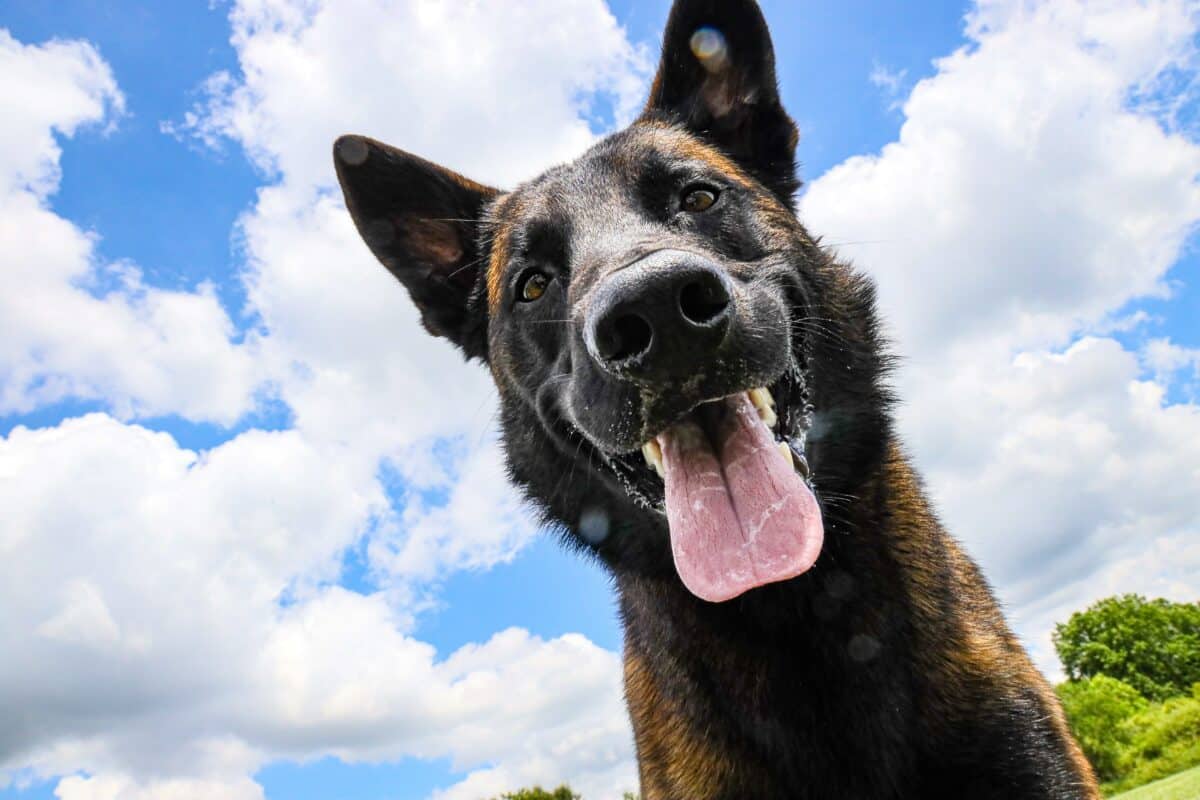The Jaguar and German Shepherd are some of the world’s most popular and beloved animals. Both have a long history of being used as loyal and protective guardians. Yet, they each have unique traits, personalities, and characteristics that make them desirable to many owners.
This article will delve into similarities and differences between these breeds to help you decide your favorite.
Jaguars vs. German Shepherds
Here’s a comparison table between the Jaguar and the German Shepherd:
| Jaguar | German Shepherd | |
|---|---|---|
| Kingdom | Animalia | Animalia |
| Phylum | Chordata | Chordata |
| Class | Mammalia | Mammalia |
| Order | Carnivora | Carnivora |
| Family | Felidae | Canidae |
| Genus | Panthera | Canis |
| Average Weight | 56-96 kg (123-211 lbs) | 22-40 kg (49-88 lbs) |
| Average Length | 1.2-1.9 m (3.9-6.2 ft) | 55-65 cm (22-26 in) |
| Habitat | Forests, grasslands, and swamps | Domesticated and urban environments |
| Diet | Carnivorous | Omnivorous, with a preference for meat |
| Lifespan | 12-15 years | 9-13 years |
| Behavior | Solitary and territorial | Social and protective, loyal to owners |
| Threat Level | Can be dangerous to humans | Generally not dangerous to humans |
Temperament

Regarding temperament, both breeds are known for their loyal and protective nature regarding their families, making them excellent guardians for homes with young children or elderly members who need extra protection.

Despite their protective nature, Jaguars and German Shepherds are affectionate with family members and enjoy being around people they know well. Furthermore, if provided with sufficient exercise, both breeds make excellent companions who will show you love and attention.
Health Problems That May Affect Both Breeds

Hip Dysplasia: Jaguars and German Shepherds can have a common genetic problem called hip dysplasia. It happens when the hip joint doesn’t form well, causing the hip bone to rub against the thigh bone. It can make it hard to walk or run and cause pain. People usually give pain relief drugs and fix them with surgery.
Learn more about the German Shepherd Hip Dysplasia Signs and Treatments.
Bloat: Jaguarsuar and German shepherds are prone to a health issue called bloat. Bloat happens when the stomach fills up with gas, causing it to twist and trap food inside. It is a severe condition that can be fatal if not treated promptly. Signs of bloat include restlessness, excessive drooling, retching, and a swollen abdomen. Treatment may involve medication and surgery based on how severe the condition is.

Skin Issues: Both breeds are prone to skin disorders such as allergies, mange mites or demodectic mites, and yeast or fungal infections, leading to itchy skin lesions or hair loss. Treatment depends on what type of skin disorder is present. Still, if mites are present, it could involve antibiotics, creams, or shampoos containing specific active ingredients such as sulfur or benzoyl peroxide.
Ear Infections: Both breeds are predisposed to ear infections due to their long ears trapping warm moist air inside them, creating an ideal environment for bacteria growth which can lead to painful redness in their ears accompanied by a strong odor from discharge coming out of them. Treatment usually involves cleaning out debris from the ear canal, followed by antibiotic drops prescribed by your veterinarian if necessary. Additionally, regular ear checks should be performed at home weekly to detect any potential infection early on.

Allergies: Jaguars and German Shepherds can also suffer from allergies which may present as itching, sneezing, redness, or hives on their skin. A food allergy typically requires avoiding all foods containing offending ingredients; environmental allergies may need medication such as antihistamines or corticosteroids and removing exposure sources like pollen, dust mites, mold, etc.
Physical Appearances

The Jaguar is a large, muscular wild cat about three to five feet long. It has a broad head with rounded small eyes and pronounced cheekbones. Its ears are short and round, its tail is long and robust, and its paws are big and powerful.

On the other hand, German shepherds are typically larger than jaguars, and their bodies are more athletic-looking, with a long muzzle and pointed ears. Their tails are thick and bushy, their paws more petite but still deceptively strong for their size.

When it comes to the head shape of these two breeds, there is quite a bit of variance depending on the bloodlines. For instance, some jaguar heads may be broad; others might be more narrow or triangular; some may have more prominent facial features, and others may be more subtle or hidden behind fur. German shepherd heads also come in many shapes, such as short-nosed, long-nosed, blocky, or foxy-looking heads, which can vary depending on the bloodline.

In terms of the shape of their ears, jaguars have short round ears, while German shepherds have pointed ears that stand upright against their heads. The tail of a jaguar may either be straight or curved at the tip, whereas German shepherd tails tend to sit low but with a slight curve at the end, giving them an alert posture when standing up straight.

Finally, there is a considerable difference between the paw sizes of both breeds; jaguars tend to have more enormous paws due to their size. In contrast, German shepherds tend to have smaller claws due to their athleticism and agility, which allows them to run faster than jaguars over shorter distances.
Characteristics

Intelligence: The Jaguar is known for being intelligent and having a good memory, while the German Shepherd is known for superior working intelligence. Both breeds possess an impressive capacity to think and problem-solve.

On the flip side, they can also be stubborn sometimes, so it’s essential to have consistent training and positive reinforcement techniques when dealing with either breed.
Training Technique: While both breeds are eager to learn, Jaguars are generally more independent-minded than German Shepherds and may require more patience when teaching new commands or tricks. German Shepherds. On the other hand, they tend to be very willing followers who thrive on praise and attention from their owners. When training either breed, it’s essential to use positive reinforcement techniques such as treats or toys to keep them motivated throughout the learning process.

Energy Level: Both breeds have high energy levels that need to be released regularly; this could include daily walks or playtime in a safe area where they can run freely without causing harm or danger. However, Jaguars have higher energy levels than German Shepherds and need more daily exercise to stay healthy and happy.
The Final Say
In conclusion, while the Jaguar and German Shepherd are lovely animals with unique characteristics, there are some significant differences between the two that should be considered in deciding your favorite.
It’s important to note that while jaguars are wild animals and German Shepherds are domesticated pets, both require responsible ownership and care to ensure their well-being. Additionally, jaguars are a protected species and should only be observed from a safe distance in their natural habitats.
Thank you for following along this article! Let’s compare the The Predator and the Tank, An Epic Battle Between Two Powerhouses and The Unbelievable Battle of Titans.
- Virgin Male Brazilian Rainbow Boa Gives Birth to 14 Babies in Portsmouth - October 20, 2024
- Man Smacks Charging Crocodile with Frying Pan - October 20, 2024
- How Native American Lunar Cycles Enhance Modern Zodiac Interpretations - October 20, 2024

